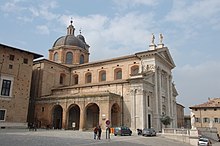Urbino
[4] The originally modest Roman town of Urbinum Mataurense ("the little city on the river Mataurus") became an important strategic stronghold during the Gothic Wars of the 6th century.
Federico's brilliant court, according to the descriptions in Baldassare Castiglione's Il Cortegiano (The Book of the Courtier, published in 1528), set standards of what would characterize a modern European "gentleman" for centuries to come.
Cesare Borgia dispossessed Guidobaldo da Montefeltro, Duke of Urbino, and Elisabetta Gonzaga in 1502, with the complicity of his father, Pope Alexander VI.
[5] In 1626, Pope Urban VIII definitively incorporated the Duchy into the papal dominions, the gift of the last Della Rovere duke, in retirement after the assassination of his heir, to be governed by the archbishop.
From July 1717 to November 1718 Urbino hosted the court of James Stuart, the exiled pretender to the British throne, who had the strong backing of the papacy.
Urbino and its territory lost many important works of art to the French, who moved objects to Paris or Milan, to the nascent galleries of the Louvre and Brera.
Instead of passing through narrow, winding streets, through the gates of the walls, now one could enter through the Porta Nuova in an easier and convenient way to arrive in the present Piazza della Repubblica and the Palazzo Ducale (the city center).
[7] On 8 September 1860 the Piedmontese troops entered Urbino from Port Saint Lucia, forcing the surrender of the last resistance of the papal army under the portico of the childhood house of Raphael.
The fascist dictatorship left its mark on the city, especially from an architectural point of view, with a fascist elementary school "Giovanni Pascoli" (1932) built on the ancient Garden of Saint Lucia (part of the duke's private gardens), the restoration of the palace-Mauruzi Gherardi, then the seat of the court, as well as the Student House, to compensate for the shortage of accommodation as a result of the large increase in university population and housing for the maimed and disabled civilians.
With the outbreak of World War II the city suffered no bombing, thanks to the large red cross painted on the roof of the Ducal Palace and an agreement between the Germans and the Allies.
[9] Urbino was liberated from the Nazi occupation on 28 August 1944, thanks to the British V Corps, Polish troops, and the heroic actions of partisan groups in the area.
The second half of the twentieth century was characterized in Urbino by the cooperation with the major public institutions (the University and the City) by the architect Giancarlo De Carlo.
Immediately after that, the Genoese architect was commissioned by the City to prepare the General Plan (1958–64) aimed at the recovery of the historical center, which had been in poor condition and was in danger of losing several neighborhoods including the Palazzo Ducale to the land subsidence below.
Subsequently, De Carlo realized several projects for the university including the college's dormitories, near the Capuchin church outside the city center, an interesting example of how architecture can merge with the surrounding landscape.
The clay earth of Urbino, which still supports industrial brickworks, supplied a cluster of earthenware manufactories (botteghe) making the tin-glazed pottery known as maiolica.
Simple local wares were being made in the 15th century at Urbino, but after 1520 the Della Rovere dukes, Francesco Maria I della Rovere and his successor Guidobaldo II, encouraged the industry, which exported wares throughout Italy, first in a manner called istoriato using engravings after Mannerist painters, then in a style of light arabesques and grottesche after the manner of Raphael's stanze at the Vatican.





